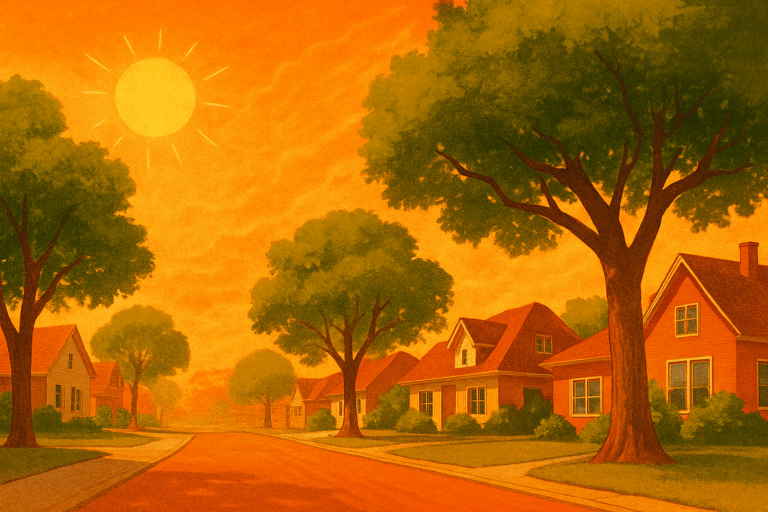
On a July afternoon in north Tulsa, temperatures soared past 95°F, baking asphalt until it felt like walking on a griddle. Beneath that relentless sun, a group of high‑schoolers knelt in the dirt along Peoria Avenue, sweat dripping from their brows as they gently lowered tiny tree saplings into fresh holes. They were part of GreenTree Tulsa, a youth‑driven program dedicated to expanding Tulsa’s canopy, and making our streets livable again.
Urban areas can be 5–10°F hotter than nearby parks, thanks to heat‑trapping surfaces like concrete and blacktop. That “urban heat island” effect doesn’t just make summer miserable, it raises energy bills, exacerbates air pollution, and puts vulnerable neighbors (young children, the elderly, and those with respiratory issues) at real risk on the hottest days.
“Shade isn’t a luxury, it’s essential,” says Sophia Martinez, one of the youth volunteers. “When we’re out here under the sun, we see firsthand how much cooler, and how much healthier, our streets could be.”
Just months before, 100‑mph winds ripped through Tulsa during a severe storm, toppling hundreds of mature trees in Oxley Nature Center and beyond. Volunteers later hauled away a million cubic yards of broken limbs and trunks, evidence of just how vulnerable our urban forest had become under extreme weather.
With so many large, mature trees suddenly gone, certain neighborhoods felt the loss most acutely. Where once a canopy of red and white oaks provided relief, residents now faced open skies and unrelenting sun.
Replanting is more than a symbolic gesture. Young trees are the future of our canopy, but they need care and community buy‑in to thrive. That’s where Up With Trees’ Citizen Forester program comes in. It trains Tulsa residents on proper planting techniques, species selection, and ongoing maintenance. Through this program, volunteers learn to plant, and then nurture, saplings so they live long enough to join the ranks of those storm‑matured giants.
GreenTree Tulsa mobilizes local teens, pairing them with mentors from city forestry and environmental nonprofits. On planting days, students handle everything from digging holes to attaching protective tree guards. They learn why species diversity matters (to resist pests like emerald ash borer) and how to water, and monitor, each new sapling until it’s ready to stand on its own.
“When I saw that first little tree take root and grow,” reflects Martinez, “I felt like we were healing our neighborhood, one tree at a time.”
Beyond youth groups, Tulsa’s Public Service Company franchise fees fund arterial‑street median plantings. In late 2023, Up With Trees partnered with the City on a $436,000 beautification project. It removed hazardous Bradford pears and northern ashes, then installed upright‑growing elm and oak varieties in medians along busy roadways. Those trees not only improve safety (fewer low‑hanging branches), they also boost biodiversity so if one species is hit by disease, others can thrive.
Without adequate shade, heat‑related illnesses climb. Hospitals in Tulsa County report increased ER visits for heat exhaustion on days above 90°F. Lack of tree cover also means more air pollutants linger at street level, aggravating asthma and other respiratory conditions.
Every degree Fahrenheit added to ambient temperature can bump electricity usage up by 1–2%. In low‑income neighborhoods, where air conditioning may be limited, that extra cost can force families to choose between cooling their homes and other essentials.
Tree canopy is often unevenly distributed. Wealthier districts enjoy mature, well‑maintained trees, while underserved areas lag behind. That disparity perpetuates health and wealth gaps, trapping some residents in hotter, less healthy environments.
Tulsa’s reforestation story isn’t just about planting trees, it’s about sustainable partnerships between nonprofits, city agencies, businesses, and residents. Yet these efforts need reliable funding to keep going year after year:
Up With Trees reports training over 1,200 volunteer caretakers since 2019, but local tree grant programs still seek matching funds to reach full capacity.
Citizen Forester workshops happen monthly, yet many attendees lack the resources to purchase proper mulch, guards, and watering equipment.
Median‑planting cycles continue through 2025, but future seasons depend on new revenue streams from city budgets and community sponsors.
Through Heart of the City, we aim to shine a spotlight on inspiring local efforts like Tulsa’s youth-led tree planting, not because Love Mobile is funding them today, but because we believe telecom providers should play a role in community wellbeing.
Our mission is to build a service that not only keeps you connected but that you can point to as a force for good. By subscribing to this newsletter, and keeping Love Mobile in mind when choosing your wireless provider, you help us make that vision a reality.
While these programs thrive today on grants, donations, and volunteer passion, your support could allow Love Mobile to:
Partner directly with local tree-planting groups
Provide ongoing grants for saplings, planting supplies, and care
Help train more community members in Citizen Forester workshops
Sponsor citywide median beautification and storm replanting efforts
In other words, when you keep Love Mobile top of mind, you help us build toward a future where our service fees fuel community projects like these—right where you live.
Never miss a story of local impact:
Subscribe to our monthly “Heart of the City” newsletter at GetLoveMobile.com/newsletter
Follow us on LinkedIn for weekly highlights and behind-the-scenes updates
Share these stories with friends who care about community, environment, education, pets, and wellness
Together, we can transform everyday connections into real-world change, one story, one subscriber, one city at a time.


Love Mobile Inc., The Cell Phone Company That Gives Back 12 N. Cheyenne Ave., Tulsa, Oklahoma 74103 [email protected] | 918-212-8199